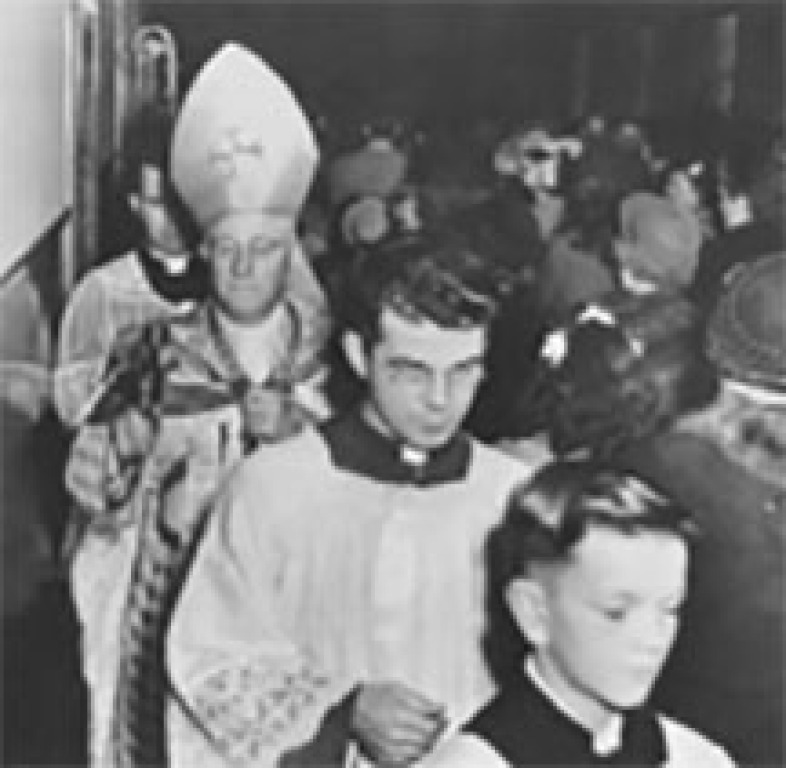The Story of the Church of the Incarnation
CHAPTER ONE: BEGINNINGS
When Ewing Township was incorporated in 1834, it was primarily farmland with a handful of scattered hamlets of 1,017 residents. The population continued to grow until it reached 10,146 residents in the 1940 census. Among those residents were Catholics without a local  Catholic Church. Those residents worshiped at three Trenton Area Churches -- St. Joachim, Blessed Sacrament, and at the Cathedral. Residents in Trenton Junction section -- later West Trenton, traveled to St. Joachim. Those who lived closer to Trenton worshiped at Blessed Sacrament and the Cathedral of St. Mary.
Catholic Church. Those residents worshiped at three Trenton Area Churches -- St. Joachim, Blessed Sacrament, and at the Cathedral. Residents in Trenton Junction section -- later West Trenton, traveled to St. Joachim. Those who lived closer to Trenton worshiped at Blessed Sacrament and the Cathedral of St. Mary.
In 1941 and 1942, the Most Reverend William A. Griffin, D.D., the sixth bishop of Trenton, foresaw the necessity for a new parish to meet the needs of the families in the Ewing area. He sent Father Bernard DeCoste, a young priest from Blessed Sacrament Parish, to locate a suitable place. A 17.56 acre site was purchased with a 365 foot frontage on Pennington Road extending back to Olden Avenue Extension. Additional property was purchased that provided access to Sutherland Road along the Shabakunk Creek. A new parish and church was planned for this property. However, due to World War II, plans were put on hold.
In 1947, the Diocese of Trenton proceeded with the expansion plan. The parish was incorporated under the title of Church of the Incarnation, Trenton, New Jersey on December 29, 1947. The pastors of Blessed Sacrament and the Cathedral were informed that the areas of their respective parishes in Ewing Township would become part of Incarnation’s boundary. The Reverend Edward A. McAndrews was named as the first pastor of the new Church of the Incarnation. The Reverend James A Rilley, an assistant at St. James in Pennington, was appointed as Father McAndrew’s associate. Having no rectory at the time, both pastor and associate resided at their rectories while organizing the new parish.
the Incarnation, Trenton, New Jersey on December 29, 1947. The pastors of Blessed Sacrament and the Cathedral were informed that the areas of their respective parishes in Ewing Township would become part of Incarnation’s boundary. The Reverend Edward A. McAndrews was named as the first pastor of the new Church of the Incarnation. The Reverend James A Rilley, an assistant at St. James in Pennington, was appointed as Father McAndrew’s associate. Having no rectory at the time, both pastor and associate resided at their rectories while organizing the new parish.
In February of 1948, the new pastor and associate moved into 1640 Pennington Road -- a home four blocks from the parish site. This would serve as a temporary rectory for the new parish. The site is currently the B & W Kids Academy. The home was formerly owned by Mr. Thomas Salt who left the property to the Cathedral Parish. The Cathedral Parish kindly gave it to Incarnation. Due to the urgent need of a church building, an existing steel structure was purchased. The structure was purchased from the John McShain Company, a Philadelphia company, also know for constructing the Pentagon, the State Department Building and the Jefferson Memorial. The building was dismantled and moved to the Ewing site. After major alterations and conversion into a church, the building could seat 300 people.
Due to the urgent need of a church building, an existing steel structure was purchased. The structure was purchased from the John McShain Company, a Philadelphia company, also know for constructing the Pentagon, the State Department Building and the Jefferson Memorial. The building was dismantled and moved to the Ewing site. After major alterations and conversion into a church, the building could seat 300 people.
The church opened its doors on June 20, 1948 with five Masses. The pastor and associate were able to accommodate the more than 1200 adults and children. The formal dedication was lead by the Most Reverend William A. Griffin on October 24, 1948.
During the time the temporary church was being erected, Father McAndrews and Father Reilly went from street to street in Ewing knocking on doors to get a more accurate census of Catholics living in the boundaries of the parish. On reviewing the census and hearing the enthusiasm of parishioners, it became evident to the pastor that a larger, more permanent church and an area for meetings and social events would be needed.
Father McAndrews took the proposal to Bishop Griffin and plans were begun for a permanent Church and auditorium. Sadly, in early 1949, Pastor McAndrews became ill confining him to the hospital. The plans were further delayed with the death of Bishop Griffin on January 1, 1950.
On March 20, 1950, the Most Reverend Bishop George W. Ahr was consecrated as the seventh Bishop of Trenton. He appointed the Reverend John J.Endebrock as administrator to assist the ailing Fr. McAndrews. Fr. Endebrock resumed the plans for a new church. The firm of Fanning and Shaw completed the plans for the church and auditorium. An informal groundbreaking was held on Fathers’Day, June 19, 1951. Bishop George W Ahr visited the parish to celebrate the sacrament of Confirmation and to place the cornerstone of the permanent church.

